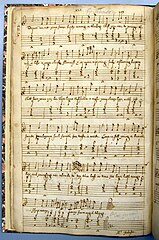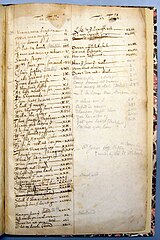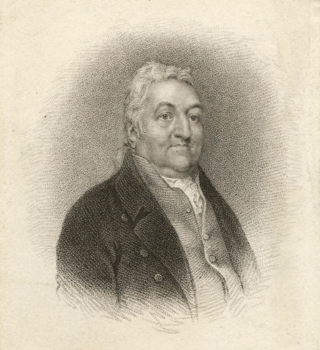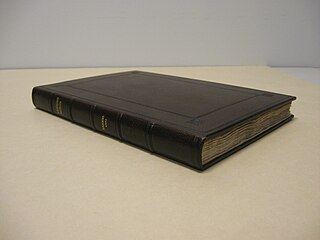| Jorgens | # ms. | Title | In ms.? | Attributions | Remarks |
|---|
| 1 | I | You meaner bewties | Not in ms. | lyric by Henry Wotton | probably written about 1612-1613; first printed in Michael East's "The Sixt Set of Bookes" (1624) |
| 2 | ii | Was euer wight | Not in ms. | lyric by Thomas Edwards | from Cephalus and Procris |
| 3 | iii | He downe d: d: | Not in ms. | | a frequent refrain of Elizabethan songs and later |
| 4 | iiii | O let vs howle | Not in ms. | music ascribed to Robert Johnson; text by John Webster | From The Duchess of Malfi ; another copy at no. 42 |
| 5 | v | I was not weary where | Not in ms. | music ascribed to Nicholas Lanier; text by Ben Jonson | The epilogue to The Vision of Delight (1617) |
| 6 | vi | Sweete staye ://: | Not in ms. | Lyric ascribed to John Donne | Ascriptions based on publications of Dowland (1612) and Gibbons (1612) |
| 7 | vii | Mrs since you soe much | Not in ms. | lyric by Thomas Campion | Published in Philip Rosseter's A Booke of Ayres (1601) |
| 8 | viii | Cloris sighte | Not in ms. | music by Richard Balls (died in 1622); lyric attributed by John Donne to William Herbert, 3rd earl of Pembroke | in Poems (1678); a song with this title appears in New Ayres and Dialogues (1678); another copy at lii |
| 9 | ix | Like hermit poore | Not in ms. | translation of a sonnet by Philippe Desportes possibly by Walter Raleigh | |
| 10 | x | Some kinde muse | Not in ms. | | |
| 11 | xi | A thousand kisses | Not in ms. | | Most likely the same as "A thousand kisses wynns my hearte from mee" in British Library manuscript Add. 24665 [23] |
| 12 | xii | As life what is soe | Not in ms. | | Found by Norman Ault in a British Library manuscript dated 1624 |
| 13 | xiii | In Sherwoode | Not in ms. | | possibly the lyric with the same title in A Musicall Dreame (1609) by Robert Jones |
| 14 | xiiii | Thou sents to me | Not in ms. | lyric by Robert Aytoun | |
| 15 | xv | Shall I weepe | Not in ms. | | |
| 16 | xvi | Goe thy wayes since | Not in ms. | | The text of stanzas 2-5 present without music; begins “Yet I will not curse those eyes” |
| 17 | xvii | Milla the glorie of whose bewteous rayes | | | A variant of the "May and Time" riddle from Thomas Morley's The First Booke of Ayres, or little short Songs (1600) |
| 18 | xviii | Thus sange Orpheus | Not in ms. | | Possibly identical to the version published in Walter Porter's Madrigales and Ayres first published in 1632 but likely composed before that |
| 19 | xix | Heare yee ladyes yt | Not in ms. | text by John Fletcher; music by Robert Johnson | From the play Valentinian |
| 20 | xx | Ist for a grace or ist for some mislike | | lyric by John Harington | First published in 1633 but found in earlier manuscripts |
| 21 | xxi | Why should pasion leade mee blinde | | | The lyric was first published in 1660 but dating earlier |
| 22 | xxii | The say Dymph, Gaho, followes to the shadie woods | | | |
| 23 | xxiii | Fi, fi, fi, fi, what doe you meane by this? | | | |
| 24 | xxiiii | Cupid is Venus only ioy | | text by Thomas Middleton | from A Chaste Maid in Cheapside ; another copy at lvi |
| 25 | xxv | Though your stragnes freet my hart | | music by Robert Jones? Thomas Campion? | |
| 26 | xxvi | When I sit as iudge betweene vertue and loues princely dame | | | |
| 27 | xxvii | When sorrowe singes a litle a litles enough | | | |
| 28 | xxviii | Wrong not deare Empress of my hearte | | | Lyric attributed to Walter Raleigh |
| 29 | xxix | What is you lacke, what would you buy | | | from The Masque of Mountebankes (1618); this version incomplete |
| 30 | xxx | Orpheus I am come | Not in ms. | lyric by John Fletcher | From The Mad Lover |
| 31 | xxxi | Sorrow: sorrow stay | Not in ms. | | Possibly the same as the one composed by John Dowland |
| 32 | xxxii | Eyes looke of [off] | Not in ms. | | A song with this title appears in other contemporaneous manuscripts |
| 33 | xxxiii | Let her giue her hand | Not in ms. | | A song with this title appears in other contemporaneous manuscripts |
| 34 | xxxiiii | Fares [Fairies?] be hence | Not in ms. | | |
| 35 | xxxv | Come pretty wanton | Not in ms. | | A song with this title appears in other contemporaneous manuscripts |
| | | | | "Haue you seene [lute]"; entry is crossed out |
| 36 | xxxvi | Shall I then relent, or: | Not in ms. | | |
| 37 | xxxvii | Sweetest loue, I doe not goe | Not in ms. | | Text possibly by John Donne |
| xxxviii | | | | No song xxxviii in list |
| 38 | xxxix | Haue you seense ye [lute] | Not in ms. | lyric by Ben Jonson | From the play The Devil is an Ass (1616); another copy at 47 (xlix) |
| 39 | xl | Rest awile you cruell cares | | music by [John Dowland] | Published in The First Booke of Songes or Ayres (1597) |
| 40 | xli | Deare doe not your faire beuty wronge | | music by Robert Johnson, text by Thomas May | from the play The Old Couple (1636); lute tablature; another copy at li; the only song in the collection with authorial ascription |
| 41 | xlii | O let vs howle some heauy note | | music by Robert Johnson | lute tablature |
| 42 | xliii | Like to the damaske rose you see | | music by Henry Lawes | lute tablature |
| 43 | xliiii | Tell mee dearest what is loue | | music by Robert Johnson; text by Francis Beaumont and John Fletcher | From the play The Captain |
| xlv | | | | No song xlv |
| 44 | xlvi | Downe [downe] afflicted soule and paye thy due | | | Appears in contemporaneous manuscripts |
| 45 | xlvii | Sit and despayre | Not in ms. | | Appears in contemporaneous manuscripts |
| 46 | xlviii | How now sheapheard | Not in ms. | | Appears in contemporaneous manuscripts |
| 47 | xlix | Haue you seene the bright lilly growe | | lyric by Ben Jonson | From the play The Devil is an Ass (1616); |
| 48 | l | Venus went wandringe Adonis to finde | | | Appears in contemporaneous manuscripts |
| 49 | li | Deare doe not your faire bewty wrounge | | music by Robert Johnson | another copy at 40 |
| 50 | lii | Cloris sighte, and sange, and wepte | | music by Alphonso Bales? | lute tablature; another copy at 8 |
| 51 | liii | Come sorrowe sitt downe by this tree | | | lute tablature |
| 52 | liiii | Come away, Come away hecket | | lyric by Thomas Middleton; music attributed to Robert Johnson | From the play The Witch |
| 53 | lv | O where am I, what may I thinke | | lyric attributed to Samuel Brooke | lute tablature |
| 54 | lvi | Cupid is Venus only ioy | | | lute tablature; another copy at 24 |
| 55 | lvii | Wherefore peepst thou enuious day? | | music by John Wilson, lyric by John Donne | lute tablature |
| 56 | lviii | You herralds of Mrs hart | | | Music attributed to John Wilson by Rimbault (who wrote in the manuscript); lute tablature |
| 57 | lix | Get you hence for I must goe | | | lute tablature |
| 58 | | Ile tell you how the rose grewe redd | | Text by William Strode | lacking accompaniment; unnumbered |




















